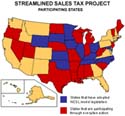|
What is the Streamlined Sales Tax Project?
The
Project is a proactive approach by states, with input from local
governments and the private sector, to design, test, and implement a
radically simplified sales and use tax system for the 21st century.
The goal of the Project is to substantially reduce or eliminate the
costs and burdens of sales tax compliance for businesses through a
combination of simplified laws and administrative policies and the
implementation of a system that would be paid for by states. Project
participants embarked on their mission to create a new, improved,
and simpler system in February 2000. Reforming sales an use tax
policies will provide online and other retailers that do business in
multiple states an easier way to calculate, collect, and remit
existing use taxes.
What are sales and use taxes?
A sales tax is
a levy placed on a good or service when it is purchased from a
company that has a physical presence - whether it is a store or
distribution center - in the same state as the consumer. When a
consumer buys a good or service from a retailer that is outside of
his or her state, they pay what's called a use tax.
Why do we need to change existing sales and use tax
laws?
America's sales and use tax system, with 7,500
state and local taxing jurisdictions across the nation, is
antiquated, terribly complex, and cumbersome to businesses in
today's new economy. One of the problems with so many taxing
jurisdictions is that they often have different laws or definitions
of what is taxable. For example, a marshmallow might be defined as a
food in one state, but as a candy - and therefore not taxed - in the
next. That arrangement makes it very difficult for online sellers
and other "remote" retailers, such as mail order companies, to know,
calculate, collect, and remit sales taxes at varying rates based on
a customer's location to different state and local governments.
How does the current tax system
work?
Currently, 45 states have a sales tax and a
complementary use tax. Under current law, retailers that sell to
consumers in a state in which they have a physical presence - called
nexus - are required to collect and remit sales taxes. Businesses
that sell to consumers in states in which they do not have nexus,
the U.S. Supreme Court has ruled, are not required to collect and
remit use taxes. In this case, though, consumers still have the
legal responsibility to calculate and pay the use tax directly to
their own state. Under the streamlined approach, businesses would
assume that responsibility.
Which states are participating in the Streamlined Sales
Tax Project?
 |
| Click here for
map |
Thirty-two states are
so-called "official" participants. They helped craft and
ultimately voted to approve model legislation that
states can independently consider and use to simplify
their tax codes. They will work together as the Project moves
forward. Seven states are participating in an "observer"
capacity. Five states do not have sales taxes. Since the Project
made the model bill available, 18 states have introduced the
legislation, and on March 1, 2001 Wyoming became the first state to
adopt streamlined sales tax legislation.
What have participants accomplished so
far?
In September 2000 participants approved a pilot
project to test specially designed software that will assume the
complete responsibility for determining, collecting, and remitting
the use tax owed on a transaction. Four states - Kansas, Michigan,
North Carolina, and Wisconsin - awarded contracts to companies
to provide the software. On December 22, 2000 the Project approved
on a 26-0 vote model legislation that states could use to implement
the new system. The model legislation addresses a variety of
simplification measures, including coming up with common definitions
of what is taxable, creating uniform rules for sourcing, determining
exemption processes, figuring out how to deal with bad debt, and
establishing a way to finance the system. There is growing momentum
in the states to adopt the model legislation (see map
above).
How will the new, simplified system
work?
Retailers and states will voluntarily
elect to participate. In order to take part, states will be
required to adopt authorizing legislation and enact certain
simplification measures, including adopting uniform product codes
and sourcing rules, developing uniform definitions of state tax
laws, creating a central, one-stop registration system, and limiting
the frequency local governments can change their tax rates. Under
the new system, small and medium sized multistate retailers would be
able to use state-certified, specially-designed software at no
expense to calculate, collect and remit use taxes for transactions
in states in which they do not have a physical presence. Larger
businesses like Sears and Wal-Mart would likely ask states to
certify their existing tax software.
Didn't Congress pass a law that specifically prohibits
states from taxing purchases made on the Internet?
No.
The Internet Tax Freedom Act (ITFA) set no restrictions on whether
states can tax sales over the Internet. Instead ITFA only prohibited
states and local governments during a three-year moratorium, from
October 1, 1998 to October 1, 2001, from adopting new taxes on
Internet access charges (like those consumers pay to AOL and other
Internet Service Providers). |